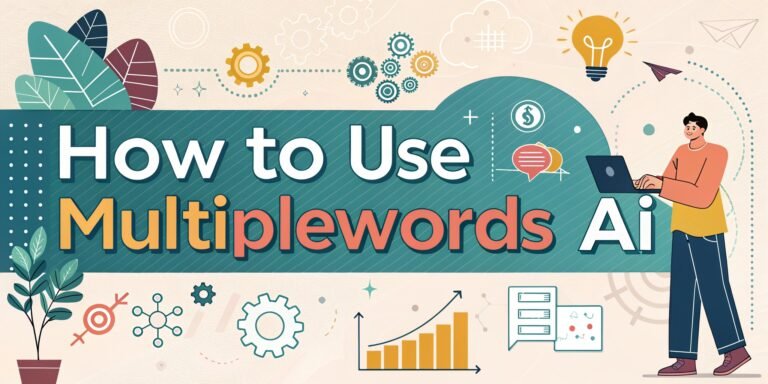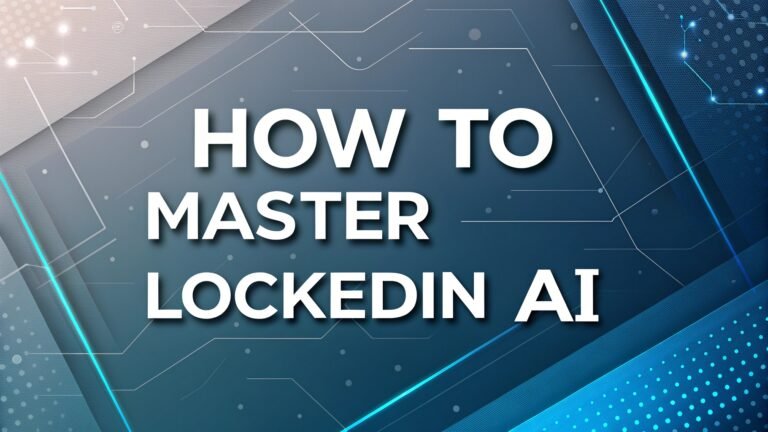How to Use a Paraphrase Tool AI: A Simple Guide for Everyone
Have you ever struggled to rewrite something in your own words? Maybe you’re working on a school project, a blog post, or just want to freshen up some text. That’s where a paraphrase tool AI comes in handy!
These tools use smart technology to help you rephrase sentences quickly and easily. In this blog post, I’ll walk you through everything you need to know about using a paraphrase tool AI tool.
From picking the right one to making your writing shine, I’ve got you covered. Stick around because this guide is packed with simple steps and friendly tips to make your writing life easier. Let’s dive in and see how these tools can save you time and boost your creativity!

Key Takeaways:

Here’s a quick rundown of what you’ll learn in this post. These points sum up the big ideas so you can jump into using a paraphrase tool with confidence.
- Paraphrase tools help you rewrite text fast. They take your words and turn them into something new without changing the meaning.
- AI makes these tools smart and easy to use. The technology understands your text and suggests fresh ways to say it.
- You can use them for many tasks. Think school essays, blog posts, emails, or even social media updates.
- Picking the right tool matters. Some are free, some are paid, and they all have different features to match your needs.
- Editing is still key. The tool gives you a start, but you tweak it to sound like you and keep it clear.
- They save time and spark ideas. You’ll work faster and maybe even find new ways to express yourself.
- Anyone can benefit. Students, writers, marketers, and professionals all find these tools useful for their projects.
This list gives you the highlights. Now, let’s break it all down step by step so you can start using a paraphrase tool like a pro!
What Is a Paraphrase Tool AI Tool?
A paraphrase tool AI tool rewrites your text in a new way. It keeps the original meaning but uses different words and sentence structures. Think of it as a helpful buddy who takes your rough draft and spins it into something fresh.
These tools run on artificial intelligence, which means they learn from tons of text to understand language patterns. That’s why they can suggest smart changes fast.
You might wonder why this matters. Well, rewriting text by hand takes time. A paraphrase tool speeds things up. Plus, it helps if you’re stuck on how to say something differently.
Whether you’re avoiding repetition or making your writing clearer, this tool does the heavy lifting. It’s like having a super-smart editor in your pocket! Best of all, most tools are simple to use, even if you’re not a tech whiz.
Why Use a Paraphrase Tool AI Tool?
You use a paraphrase tool to save time and effort. Writing the same idea in new words can be tough. This tool does it for you in seconds.
It’s great when you’re racing against a deadline or juggling multiple tasks. Imagine you’ve got a blog post due tomorrow—pop your draft into the tool, and boom, you’ve got a fresh version to work with.
Another reason is creativity. Sometimes, you hit a wall and can’t think of new ways to phrase things. The AI gives you options you might not have considered.
It’s a little nudge to get your ideas flowing again. Plus, it helps avoid copying others accidentally, which is super important for students and writers. In short, it makes your work easier and better.
How Does a Paraphrase Tool AI Tool Work?
A paraphrase tool works by analyzing your text. It uses AI to break down sentences and understand their meaning. Then, it swaps out words with synonyms and rearranges the structure. The result? A new version that says the same thing differently. Most tools let you paste your text into a box, hit a button, and see the magic happen.
The AI behind it is trained on huge amounts of data. That’s how it knows which words fit and how to keep the tone right. Some tools even offer modes like “formal” or “casual” to match your style.
Pretty cool, right? You don’t need to know the techy details—just type, click, and enjoy the rewrite. It’s fast, simple, and gets the job done.
Who Can Benefit from a Paraphrase Tool AI Tool?
Anyone can benefit from a paraphrase tool. Students use it to rewrite essays and avoid plagiarism. Bloggers freshen up old posts to keep readers hooked. Marketers tweak ads or emails to sound punchy and new. Even professionals use it for reports or presentations to make them clear and polished.
If you write anything at all, this tool is for you. It doesn’t matter if you’re a beginner or a pro. Everyone needs a little help sometimes! The tool levels the playing field, giving you a quick way to improve your words. Whether you’re in school, running a business, or just posting online, it’s a game-changer.
How to Choose the Right Paraphrase Tool AI Tool?
You choose a tool based on your needs. First, decide if you want a free or paid one. Free tools like Grammarly’s paraphraser or Quillbot work great for basic tasks. Paid ones, like Jasper or Copy.ai, offer extra features like tone settings or longer text limits. Check what each tool offers before you pick.
Next, look at ease of use. Some tools have simple layouts—paste your text, click, and go. Others might have more buttons but give you better control. Try a few to see what feels right. Also, think about output quality. Test a sentence and see if the rewrite sounds natural. A good tool fits your style and saves you time.
How to Get Started with a Paraphrase Tool AI Tool?
You get started by picking a tool. Let’s say you go with Quillbot—it’s free and popular. Visit their website or download the app. Sign up if needed, but many tools let you start without an account. Once you’re in, find the text box where you’ll paste your writing.
Type or copy your text into the box. Hit the “Paraphrase” button, and watch it work. In seconds, you’ll see a new version of your text. It’s that easy! Play around with it—try a short sentence first to get the hang of it. Most tools are beginner-friendly, so you’ll be up and running fast.
How to Input Text into a Paraphrase Tool AI Tool?
You input text by copying and pasting it. Write your sentence or paragraph in a document first. Highlight it, right-click, and copy. Then, go to the paraphrase tool’s website or app. Find the input box—it’s usually front and center. Click inside it, paste your text, and you’re set.
Some tools let you upload files too. If you’ve got a big document, look for an “Upload” button. Click it, choose your file, and let the tool load it. Either way works great! Once your text is in, hit the paraphrase button, and the AI takes over from there.
How to Adjust Settings in a Paraphrase Tool AI Tool?
You adjust settings to control the output. Not all tools have this, but many do. For example, Quillbot offers modes like “Standard,” “Fluency,” or “Creative.” Pick one that fits your goal—Standard keeps it basic, Creative shakes things up more. Click the mode you want before paraphrasing.
Some tools let you set the tone too, like “Formal” or “Casual.” Look for a dropdown menu or slider in the interface. Play with these options! If the tool doesn’t have settings, it’ll still rewrite your text, but you get less say in how it sounds. Adjust, click, and see what works best.
How to Review and Edit the Output?
You review the output by reading it carefully. The tool gives you a new version, but it’s not perfect yet. Check if it keeps your original meaning. Sometimes, the AI picks odd words or changes the vibe. If it feels off, tweak it yourself—swap a word or fix a sentence.
Editing makes it yours. Add your voice to the text. Maybe the tool made it too stiff, so loosen it up a bit. You’re the boss here! Highlight any weird spots in bold or italics as you go, then smooth them out. This step turns a good rewrite into a great one.
How to Use a Paraphrase Tool for School Projects?
You use a paraphrase tool for school by rewriting sources in your own words. Find a paragraph from a book or article you’re using. Paste it into the tool and let it rephrase it. This helps you avoid copying exact words, which keeps your work original and safe from plagiarism.
After the tool rewrites it, check the output. Make sure it still makes sense for your project. Add a citation to give credit to the source. It’s a win-win! You save time, learn to rephrase, and stay honest in your work. Teachers love that, and it boosts your skills too.
How to Use a Paraphrase Tool for Blog Writing?
You use a paraphrase tool for blogs to refresh your content. Got an old post that’s stale? Copy a chunk of it into the tool. Let it rewrite the text, then edit it to fit your voice. This keeps your blog lively without starting from scratch.
It’s also great for brainstorming. Stuck on a new post? Write a rough idea, paraphrase it, and see new angles pop up. Readers stay hooked with fresh words! Just tweak the output so it sounds like you, and you’ve got a post that’s ready to shine.
How to Avoid Plagiarism with a Paraphrase Tool?
You avoid plagiarism by using the tool to rewrite, not copy. Take someone else’s idea, run it through the tool, and get a new version. Then, double-check it’s different enough from the original. The tool helps, but it’s not foolproof—your edits seal the deal.
Always cite the source too. Even if the words are new, the idea isn’t yours. Add a note like “Inspired by [source]” or a formal citation. This keeps you safe and honest. Pair the tool with your own changes, and plagiarism won’t be an issue.
How to Combine a Paraphrase Tool with Your Writing Skills?
You combine the tool with your skills by using it as a starting point. Write your draft first. Then, run it through the tool to see new ways to say it. Pick the best parts of the output and mix them with your original ideas.
Your skills shine in the edits. The tool might miss your tone or style, so fix that yourself. It’s a team effort! The AI speeds up the process, but your creativity and voice make it special. Together, you create something polished and unique.
What Are the Limits of a Paraphrase Tool AI Tool?
A paraphrase tool has limits. It can’t fully understand context like a human can. Sometimes, it picks wrong synonyms or messes up the meaning. Technical or super-specific text might trip it up too—like science jargon or poetry.
It also won’t add new ideas. The tool reshuffles what you give it, nothing more. You still drive the creativity! If you lean on it too much, your writing might sound robotic. Use it as a helper, not a replacement, and you’ll stay ahead of its flaws.
Tips for Getting the Best Results from a Paraphrase Tool?
You get the best results by starting with clear text. Write simple, direct sentences for the tool to work with. Confusing or messy input leads to weird output. Keep it short at first—test a paragraph, not a whole essay.
Edit the results too. Don’t just take what it gives you. Add your flair and fix any clunky spots. Experiment a bit! Try different tools or settings to see what clicks. With practice, you’ll figure out how to make the tool work for you.
FAQs
What Is the Best Free Paraphrase Tool AI Tool?
The best free tool depends on your needs. Quillbot is a top pick—it’s easy, fast, and offers solid rewrites. Grammarly’s free version also works well for simple tasks. Try both and see which fits your style.
Can a Paraphrase Tool Replace Human Writing?
No, it can’t replace you. The tool rewrites text but lacks your unique voice and ideas. It’s a helper, not a writer. You still need to guide it and add your touch to make it great.
Is Using a Paraphrase Tool Cheating?
It’s not cheating if you use it right. Rewriting with the tool and citing sources is fair game. But passing off unedited output as your own? That’s shady. Use it to assist, not to fake your work.
How Do I Know If the Paraphrased Text Is Good?
You know it’s good if it keeps the original meaning and sounds natural. Read it aloud—does it flow? Check for odd words or shifts in tone. Edit until it feels right to you.

I’m Liza, the founder and author of Liza AI Blog, where I share my passion for artificial intelligence through insightful guides and updates. I’m dedicated to making AI accessible to everyone, and I strive to create a community that’s both informed and engaged. Through my blog, I aim to promote a deeper understanding and appreciation of AI and its potential to shape our future. You can reach me at lizaaiblog@gmail.com or follow me on social media to stay updated on the latest AI news and trends.







